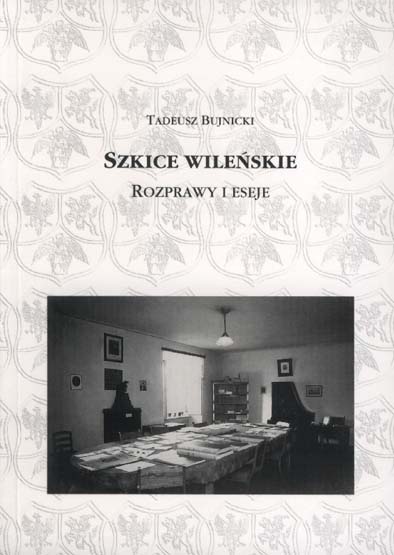|
The volume consists of 19 works preceded by a short introduction. They cover the aspects of literary life and literature - mostly poetry - of Vilnius and partially of Lithuania in the 19th and 20th centuries. The major part of the book are works that focus on the period between the two World Wars. Written over a long period but mostly during the last decade of the 20th century, these works attempt at the definition of the less-known aspects of the Vilnius literary world from a variety of angles, trying at the same time to grasp the particulars of that world. To a great extent, the authors make use of the so far poorly researched materials from Vilnius libraries and archives, referring to books, dailies and periodicals preserved in but single copies. The works contained in the volume try also to mark new trends in research, especially at the interconnection of the ethnically varied cultures and literatures of Vilnius and the Vilnius Region. This is especially true about the presence of Lithuanian and Belorussian elements and their function in the shaping of the phenomenon of Vilnius literary life. Some of the works focus on researching of the Romantic - mostly Mickiewiczian - tradition that formed an image of “the own” world, characteristic for this literature, and defined by the consciousness of community of the inhabitants of the former Grand Duchy of Lithuania.
The volume opens with two dissertations, Jeziora romantyczne. Model Świtezi (Romantic Lakes. The Model of Lake Świteź) and Oczyma Galicjanina. Mickiewiczowskie i realne Wilno Stanisława Tarnowskiego (With the Eyes of Galician. Mickiewicz’s and Real Vilnius of Stanisław Tarnowski). Both are concerned with the forms of presence of the 19th-century tradition of Romanticism and Mickiewicz in Polish cultural and literary awareness. In the first, the focus is on the semantics of the lakes that form the literary space of Lithuania, and the impact of Mickiewiczian standard. The latter presents the impressions of a “stranger”: a tourist who perceives the city with its literary and cultural setting from the outside. In a spacious essay-report from his stay in Vilnius and in Lithuania, Stanisław Tarnowski, confronts his literary imaginations based on the classic works of Mickiewicz with the reality of the 1870s. Both the texts are an introduction to one of the main themes of the other works; interpreting the manner in which the romantic tradition continued to shape the image and cultural relationships in the former capital of the Grand Duchy until the end of the 20th century.
The following works concentrate on the general characteristics of the literary life of Vilnius in the first half of the 20th century (Życie literackie Wilna w I połowie XX wieku. Kierunki badań (The literary life of Vilnius in the first half of he 20th century. Directions of research), Polskojęzyczne pisarstwo Litwinów w Wilnie (Polish-Language Works by Lithuanians in Vilnius) and Wątki litewskie i białoruskie w międzywojennej poezji wileńskiej (Lithuanian and Belorussian Themes in Vilnius Poetry 1918-1939). These dissertations are an attempt at pointing the new fields of research. Especially the latter of the two texts tackles a range of questions that have as yet been poorly recognised in its attempt to define the variety of functions and meanings of the use of the Polish language in journalism and literature by Lithuanians living in Vilnius. Another, largest group of texts are dissertations devoted to the Vilnius poetry from the period between the two World Wars, its themes, and its manners of operation in the literary life of Vilnius. This section begins with a synthetic attempt at a poetic presentation of the city (Obraz Wilna w międzywojennej poezji wileńskiej (Image of Vilnius in Vilnius Poetry 1918-1939). The following works concentrate on the less-known themes of work of the Żagary group and the group’s followers (Między Sekcją Twórczości Oryginalnej a „Żagarami” (Between the Section of Original Creation and the Żagary), Tradycje romantyczne na wileńskich Środach literackich (Romantic Traditions at Vilnius Literary Wednesdays), Regionalny pejzaż Żagarystów (The Regional Landscape by Members of the Żagary), Żagaryści „drugiej linii” (“Second Line” Members of the Żagary), Kulturotwórcza rola kwartalnika „Środy Literackie” (Culture-Shaping Role of the Środy Literackie Quarterly), and on the presentation of persons connected with the group and the university literary and scientific milieu (Przyjaźń „Żagarystów”. (Teodor Bujnicki i Czesław Miłosz) (Friendships in the Żagary. (Teodor Bujnicki and Czesław Miłosz)), Tadeusz Byrski z Wilnem w tle (Tadeusz Byrski with Vilnius in the Background), and Manfred Kridl i jego „szkoła formalna” (Manfred Kridl and his „ formal school”) complemented by a treatise on the lighter works of Vilnius professors: Od „Szopek Akademickich” do „Smorgonii” (From Szopki Akademickie to Smorgonia)). Texts of the last group are devoted to current problems: a general dissertation entitled Wilno: tradycje formujące polską świadomość narodową na współczesnej Litwie (Vilnius: traditions forming the Polish National Awareness in Contemporary Lithuania), an article on selected aspects of borderland literature (Miejsca porzucone i miejsca opuszczone. Pamięć „wygnania” i kresowe nurty w prozie polskiej (Places Forsaken and Places Deserted. The Memory of “Exile” and Borderland Themes in Polish Prose), and attempts at a closer definition of the character of contemporary cultural and literary position of the Polish minority living in Vilnius (Literatura emigracyjna w polskim środowisku wileńskim, Współczesne polskie życie literackie Wilna (pierwsza dekada w niepodległej Litwie) (Émigré Literature in the Polish Community of Vilnius, Contemporary Polish literary Life of Vilnius (The First Decade in the Sovereign State of Lithuania)).
Most of the works included in the book were written in Vilnius and are based on library and archive research made in the city. The research, to a great extent, depended on the direct contacts with the Polish scientific and literary world of the city. The range of resources included also the remains of the home archives of Teodor Bujnicki, including manuscripts and typed texts as well as rare printed works.
|

|